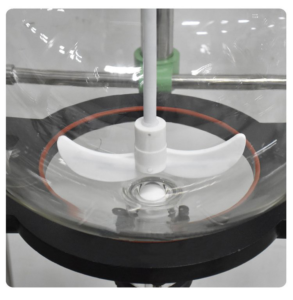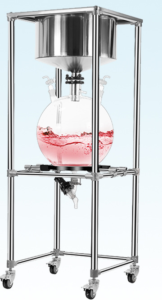In the evolving landscape of chemical processing and laboratory experimentation, the cooling single layer reactor has emerged as a critical tool for thermal control and chemical stability. These reactors serve a wide array of functions, from solvent distillation to compound synthesis, where precise thermal regulation is crucial. This article provides a detailed technical exploration of cooling single layer reactors, emphasizing their structural components, use cases, and how their market performance compares—focusing on the innovative designs offered by Equilrxnlab.
Defining the Cooling Single Layer Reactor
A cooling single layer reactor typically consists of a glass vessel—often borosilicate—engineered for thermal resilience and chemical inertness. Unlike double-layer reactors, these units do not feature a built-in jacket for external heating or cooling circulation. Instead, temperature control is typically achieved via external heating mantles or integrated electric heating systems with an air-cooling mechanism, which provides significant flexibility in lab-scale reactions.
Key Characteristics:
- Transparent design: Enables visual monitoring of reactions
- Electric heating integration: Provides uniform and efficient heat distribution
- Cooling capability: Prevents thermal degradation of sensitive compounds
- Scalability: Suitable for both research and pilot-scale synthesis
A representative example of this configuration is the AKDF-20L Electric Heating Single Layer Glass Reactor by Equilrxnlab.
Detailed Look at the AKDF-20L Model
Equilrxnlab’s AKDF-20L glass reactor exemplifies the practical integration of heating and cooling functionalities in a compact, laboratory-compatible unit. Designed to serve complex synthesis requirements, this reactor includes:
- Material: High-grade borosilicate glass (GG17)
- Capacity: 20 Liters
- Heating Method: Electric mantle with digital temperature control
- Cooling Feature: Condenser setup for vapor recondensation
- Stirring Mechanism: Adjustable-speed motor with high torque
- Temperature Range: Room temperature to 250°C
- Vacuum Sealing: Supports vacuum distillation and reflux operations
This design facilitates safe and efficient reaction control, ensuring accuracy in both academic and industrial settings.
Why Cooling Single Layer Reactors Matter
The significance of cooling single layer reactors lies in their application diversity. Their ability to handle exothermic and endothermic reactions makes them indispensable in:
- Pharmaceutical synthesis
- Fine chemical production
- Petrochemical research
- Material science and nanotech labs
Their streamlined structure also makes them more affordable and easier to maintain than jacketed or multilayer counterparts, especially in budget-conscious R&D environments.
Factors Affecting Market Selection
When evaluating options in the cooling single layer reactor category, professionals must consider several performance and budget-oriented factors:
1. Thermal Precision
Reliable temperature control ensures reproducible results. Units like Equilrxnlab’s AKDF-20L feature programmable controllers that maintain tight thermal tolerances.
2. Safety and Durability
Borosilicate construction and pressure-rated components reduce risks during vacuum operations.
3. Ease of Cleaning and Maintenance
The open, single-layer design simplifies cleaning—vital for labs working with diverse chemical groups.
4. Footprint and Integration
Compact systems are easier to install alongside analytical instruments or within fume hoods.
Equilrxnlab: A Brand Committed to Precision
Equilrxnlab is recognized for its commitment to precision chemical equipment. The brand’s extensive product line—accessible via their digital catalog—includes a range of reactors, distillation units, and glass systems engineered for performance and adaptability.
The AKDF-20L model is especially suited to applications requiring efficient temperature cycling and high-visibility reaction monitoring. Customers can also explore product demonstrations, technical tips, and equipment insights via Equilrxnlab’s active presence on YouTube, Instagram, and Facebook.
Comparative Market Analysis
While single-layer reactors are generally more cost-effective than jacketed variants, there remains considerable variability in pricing depending on build quality, automation, and supplier service levels. A comparative overview is provided below:
| Model Type | Capacity | Price Range (USD) |
|---|---|---|
| Basic glass reactor | 10–20L | $1,200 – $2,500 |
| With electric heating | 10–30L | $2,000 – $4,500 |
| With integrated cooling | 10–50L | $3,000 – $6,000 |
The AKDF-20L by Equilrxnlab sits within the mid-tier of this spectrum, offering an optimal balance of performance and cost.
Technical Support and Customization
Another key strength of Equilrxnlab is its commitment to post-sales technical support. Whether you’re dealing with installation, calibration, or replacement parts, their team ensures continuity in lab operations. For institutions with unique experimental requirements, custom configurations are available through the contact portal.
Toward Smarter Laboratory Investment
For professionals looking to optimize their workflows, investing in a high-performance cooling single layer reactor is a strategic choice. The AKDF-20L model from Equilrxnlab stands as a benchmark in terms of quality, reliability, and adaptability—an ideal asset for both academic labs and industrial R&D teams.
Users can follow [Equilrxnlab’s social platforms](https://www.youtube.com/@equilrxnlab, https://www.instagram.com/equilrxnlab/, https://www.facebook.com/equilrxnlab) to stay updated on product innovations and applications, while direct inquiries can be made through their contact page.
As laboratory needs evolve, so too must the equipment that supports them. A well-designed cooling single layer reactor plays a central role in enabling safe, repeatable, and high-efficiency chemical synthesis. The AKDF-20L exemplifies how thoughtful engineering meets scientific demand—an embodiment of Equilrxnlab’s core mission.




